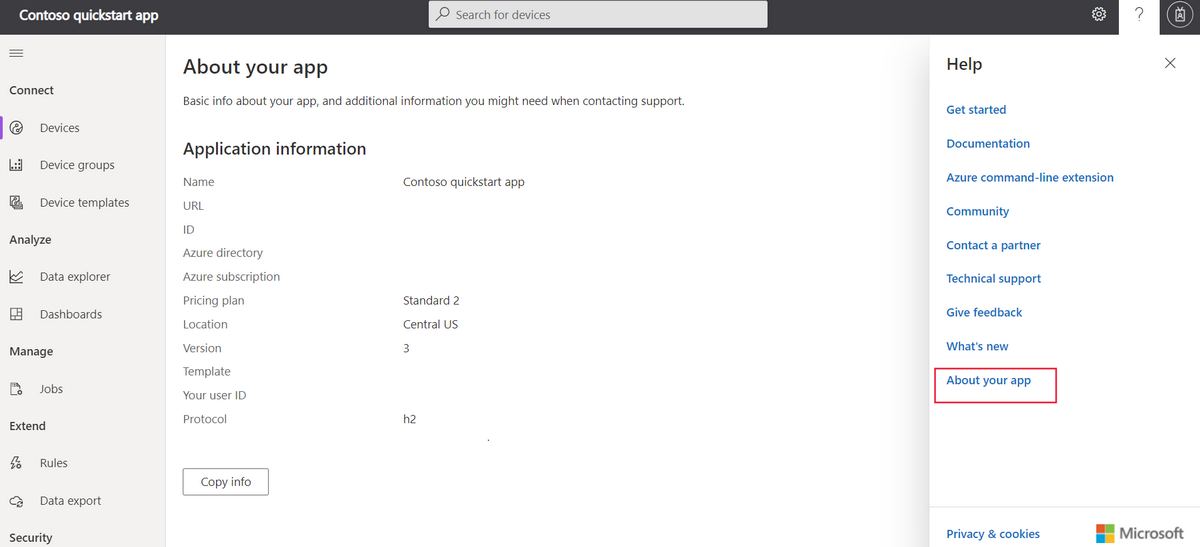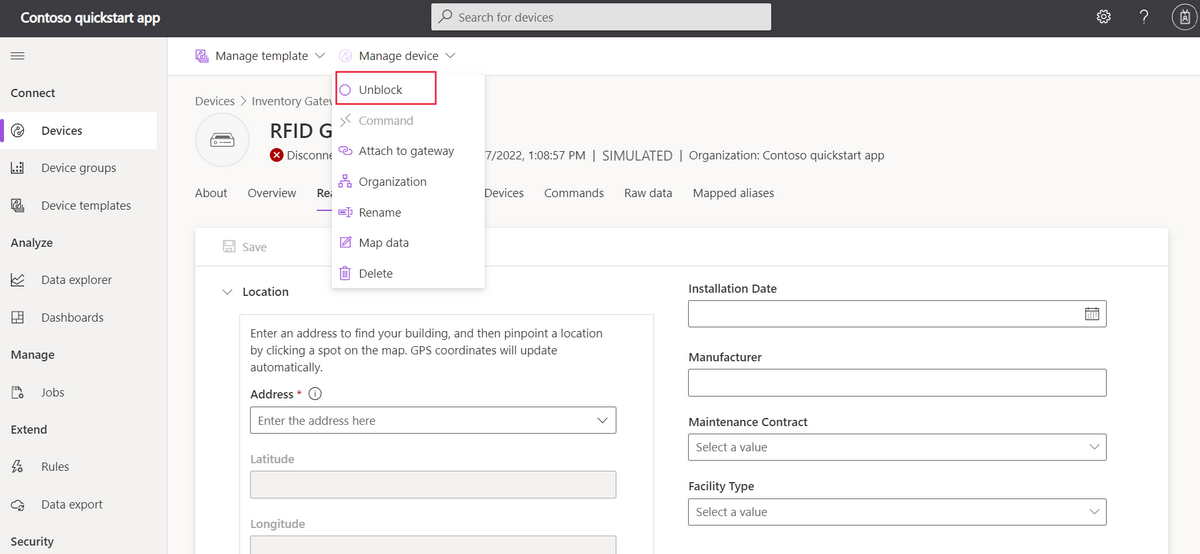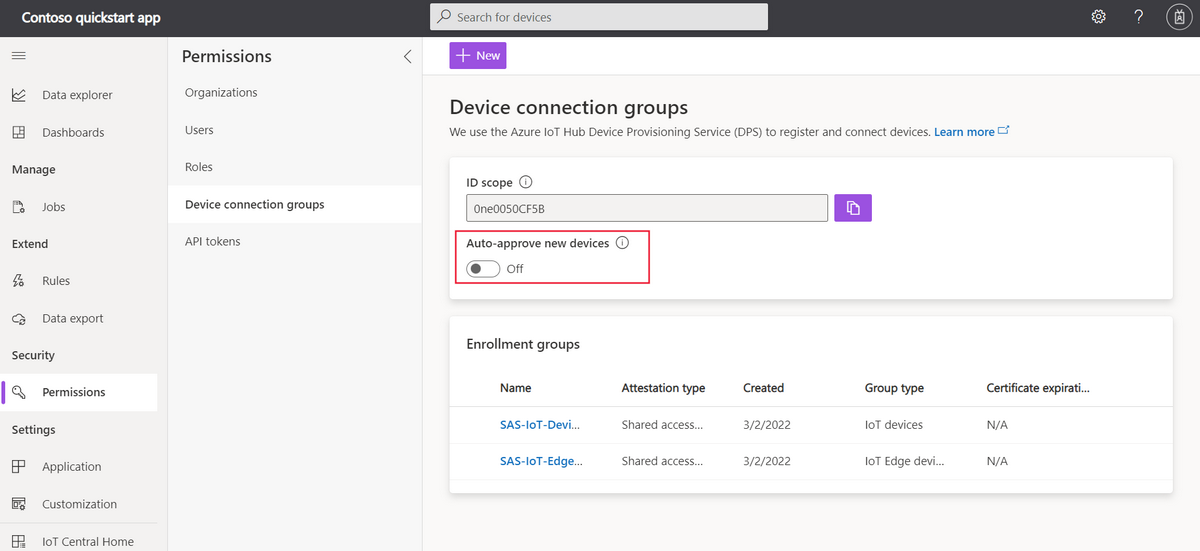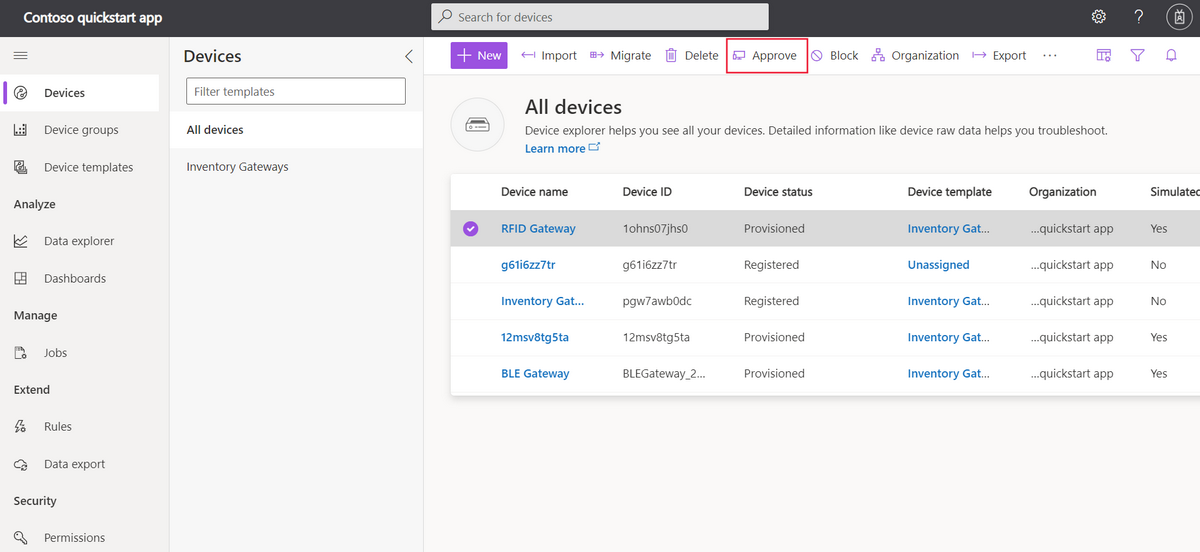General
How do I get information about my application?
You might need:
- This information if you contact support.
- The Azure subscription your application uses to locate billing information in the Azure portal.
- The application's ID when you're working with the REST API.
- The application's version to complete tasks such as adding a connector.
To get information about your IoT Central application:
Select the Help link on the top menu.
Select About your app.
The About your app page shows information about your application:

Use the Copy info button to copy the information to the clipboard.
How many IoT Central applications can I deploy in my subscription?
Each Azure subscription has default quotas that could impact the scope of your IoT solution. IoT Central limits the number of applications you can deploy in a subscription to 100.
How do I file a ticket with customer support?
If you need help, you can file an Azure support ticket.
For more information, including other support options, see What are the Azure IoT support and help options?.
Where can I learn more about IoT Hub?
Azure IoT Central uses Azure IoT Hub as a cloud gateway that enables device connectivity. IoT Hub enables:
- Data ingestion at scale in the cloud.
- Device management.
- Secure device connectivity.
To learn more about IoT Hub, see Azure IoT Hub.
Where can I learn more about the Device Provisioning Service (DPS)?
Azure IoT Central uses DPS to enable devices to connect to your application. To learn more about the role DPS plays in connecting devices to IoT Central, see How devices connect. To learn more about DPS, see What is Azure IoT Hub Device Provisioning Service?.
Pricing
How do I change my application pricing plan
Applications that use a standard pricing plan are charged per device, with the first two devices free, per application.
In the pricing section, you can upgrade or downgrade your Azure IoT pricing plan at any time.
Go to the Pricing page in the Application section.

Select the Plan and then select Save to upgrade or downgrade.
Devices
How do I register a device with my IoT Central application?
There are three ways you can register a device in your IoT Central application:
- Automatically register devices when they first try to connect. This scenario enables OEMs to mass manufacture devices that can connect without first being registered. To learn more, see Automatically register devices.
- Add devices in bulk from a CSV file. To learn more, see Import devices.
- Use the Devices page in your IoT Central application to register devices individually. To learn more, see Add a device.
How do I transfer a device from IoT Hub to IoT Central?
A device can connect to an IoT hub directly using a connection string or using the Device Provisioning Service (DPS). IoT Central always uses DPS.
To connect a device that was connected to IoT Hub to IoT Central, update the device with:
- The Scope ID of the IoT Central application.
- A key derived from the application's group SAS key or X.509 certificate.
To learn more, see How devices connect.
To interact with IoT Central, there must be a device template that models the device capabilities. To learn more, see What are device templates?.
How do I check for credential issues if a device isn't connecting to my IoT Central application?
The Troubleshooting in Azure IoT Central article includes steps to diagnose connectivity issues for devices.
How do I unblock a device?
When a device is blocked, it can't send data to your IoT Central application. Blocked devices have a status of Blocked on the Devices page in your application. An operator must unblock the device before it can resume sending data:

When an operator unblocks a device the status returns to its previous value, Registered or Provisioned.
How do I approve a device?
If the device status is Waiting for Approval on the Devices page, it means the Auto approve option is disabled:

An operator must explicitly approve a device before it starts sending data. Devices not registered manually on the Devices page, but connected with valid credentials has the device status Waiting for Approval. Operators can approve these devices from the Devices page using the Approve button:

How do I assign a device to a device template?
If the device status is Unassigned, it means the device connecting to IoT Central doesn't have an assigned device template. This situation typically happens in the following scenarios:
- A set of devices is added using Import on the Devices page without specifying the device template.
- A device was registered manually on the Devices page without specifying the device template. The device then connected with valid credentials.
The operator can assign a device to a device template from the Devices page using the Migrate button. To learn more, see Manage individual devices in your Azure IoT Central application > Migrate devices to a template.
Users
My administrator says I've been added to an application, but I can't access it. How do I get access?
The first time you access the application, you must navigate to the application URL link you received from the administrator
Organizations
How many organizations can an application contain?
You can have up to 200 organizations, including nested organizations.
Can a device belong to multiple organizations?
No, devices can only belong to one organization. You can move a device to a different organization.
Can a user be assigned to multiple organizations?
Yes, a user can belong to one or more organizations. For each organization assignment, the user can also have a different role. For example, Tom can be an administrator at Plant A, and an operator in Plant B.
Can device groups, dashboards, and jobs be associated with multiple organizations?
No, experiences such as device groups, dashboards, and jobs are associated with a single organization.
Monitoring and logging
What are the differences between monitoring an IoT Central application in the Azure portal and using the audit logs within in IoT Central application.
Monitoring in the Azure portal is useful for operations monitoring. The audit log in an IoT Central application lets you see who made changes to entities within the application.
Can I extend the audit log to store more than 30 days of data?
Currently, you can't store more than 30 days of data in the audit log. Entries older than 30 days are deleted automatically.